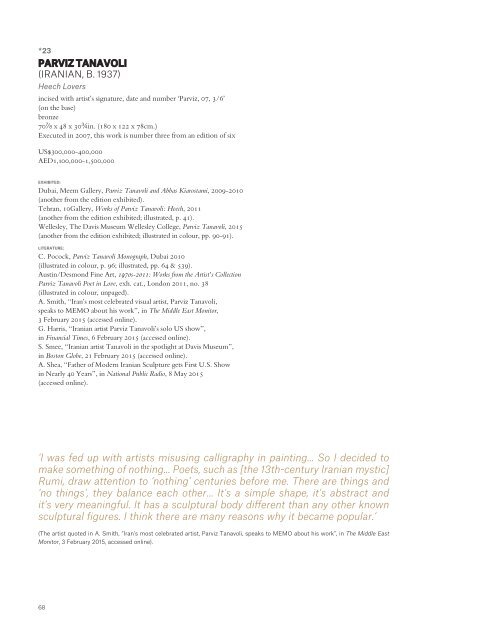NOW AND TEN
DUB1241_SaleCat
DUB1241_SaleCat
Create successful ePaper yourself
Turn your PDF publications into a flip-book with our unique Google optimized e-Paper software.
*23<br />
PARVIZ TANAVOLI<br />
(IRANIAN, B. 1937)<br />
Heech Lovers<br />
incised with artist’s signature, date and number ‘Parviz, 07, 3/6’<br />
(on the base)<br />
bronze<br />
70√ x 48 x 30æin. (180 x 122 x 78cm.)<br />
Executed in 2007, this work is number three from an edition of six<br />
US$300,000-400,000<br />
AED1,100,000-1,500,000<br />
EXHIBITED:<br />
Dubai, Meem Gallery, Parviz Tanavoli and Abbas Kiarostami, 2009-2010<br />
(another from the edition exhibited).<br />
Tehran, 10Gallery, Works of Parviz Tanavoli: Heech, 2011<br />
(another from the edition exhibited; illustrated, p. 41).<br />
Wellesley, The Davis Museum Wellesley College, Parviz Tanavoli, 2015<br />
(another from the edition exhibited; illustrated in colour, pp. 90-91).<br />
LITERATURE:<br />
C. Pocock, Parviz Tanavoli Monograph, Dubai 2010<br />
(illustrated in colour, p. 96; illustrated, pp. 64 & 539).<br />
Austin/Desmond Fine Art, 1970s-2011: Works from the Artist’s Collection<br />
Parviz Tanavoli Poet in Love, exh. cat., London 2011, no. 38<br />
(illustrated in colour, unpaged).<br />
A. Smith, “Iran’s most celebrated visual artist, Parviz Tanavoli,<br />
speaks to MEMO about his work”, in The Middle East Monitor,<br />
3 February 2015 (accessed online).<br />
G. Harris, “Iranian artist Parviz Tanavoli’s solo US show”,<br />
in Financial Times, 6 February 2015 (accessed online).<br />
S. Smee, “Iranian artist Tanavoli in the spotlight at Davis Museum”,<br />
in Boston Globe, 21 February 2015 (accessed online).<br />
A. Shea, “Father of Modern Iranian Sculpture gets First U.S. Show<br />
in Nearly 40 Years”, in National Public Radio, 8 May 2015<br />
(accessed online).<br />
‘I was fed up with artists misusing calligraphy in painting... So I decided to<br />
make something of nothing... Poets, such as [the 13th-century Iranian mystic]<br />
Rumi, draw attention to ‘nothing’ centuries before me. There are things and<br />
‘no things’, they balance each other... It’s a simple shape, it’s abstract and<br />
it’s very meaningful. It has a sculptural body diferent than any other known<br />
sculptural fgures. I think there are many reasons why it became popular.’<br />
(The artist quoted in A. Smith, “Iran’s most celebrated artist, Parviz Tanavoli, speaks to MEMO about his work”, in The Middle East<br />
Monitor, 3 February 2015, accessed online).<br />
68


